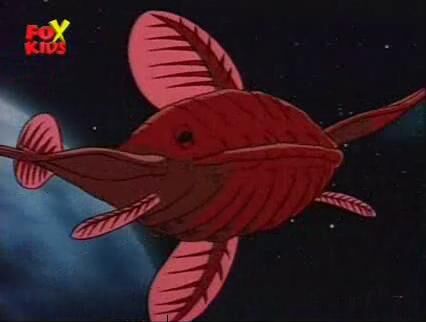The Acanti are an ancient, billion-year-old spacebound species, who have been around as long as life has existed in the universe, roaming the cosmos in search of knowledge and singing to the stars. A race with pure souls that harm no one, when Acanti die, they hurl themselves into the core of a star, releasing their soul. The Prophet-Singer among the Acanti is the caretaker of the racial soul to which all Acanti are bound. When a Prophet-Singer dies and releases its soul, it passes on to the next Prophet-Singer.[5]
History
Origin
The Acanti were among the first lifeforms to develop in the cosmos and were the first curious sentients. They roamed space passively in the pursuit of knowledge.[6]
The Brood
When the Brood arrived in the Milky Way galaxy ages ago, they saw the potential of the Acanti as living faster-than-light transportation. The Brood therefore enslaved the race by infecting individual Acanti with the Slaver Virus, including the Prophet-Singer. When the Prophet-Singer later died, its carcass was left on Sleazeworld. As the Prophet-Singer had not released its soul by plunging into the core of a star, the Acanti race continued to remain bound to the dead Prophet-Singer which the Brood knew. With the assistance of the X-Men and Binary, the soul of the dead Prophet-Singer was released, and the Acanti race was freed from bondage with a new Prophet-Singer to lead them.[5] The Brood nevertheless continued to use the Acanti as ships.[7]
Biology
Acanti are gargantuan creatures, ranging in size from a few miles in length to hundreds of miles long. One Acanti that encountered the Starjammer, easily dwarfed the 38-mile long dreadnought and swallowed the ship.[8] The planet-bound corpse of the Prophet-Singer was colossal compared to other Acanti, spreading past the horizon and its rib bones reaching above the breathable atmosphere of the planet.[9]
The Chitauri had bred Acanti with Starsharks in order to create their Leviathans.[10]
Alternate Realities
Earth-13371
In this reality, Xavier somehow became an Acanti.[11] Eventually, he became infested by the Brood, and his psychic potential was used by the Brood Queen.[12]
Earth-14412
Ego the Necroworld consumed the last of the Acanti.[3]

Earth-92131
On Earth-92131, an Acanti was enslaved by the Brood to be their vessel. It was freed when Professor X used his psychic powers to break the Brood's control. The Brood (called "The Family") couldn't stand the Acanti's song, while the X-Man Rogue found it beautiful.[13]
Earth-TRN912

One Acanti was encountered by the Guardians of the Galaxy and was about to attack them, but was killed by Magus. Later on, a group of Acanti were seen accompanying Lady Hellbender.[14]
Moira II.4
During an interstellar war, Arakko was mostly destroyed and forced to be relocated on an Acanti to escape. What was left of the X-Men found refuge on the Acanti which was then attacked by Orbis Stellaris's forces.[15]Powers and Abilities
Powers
Superhuman Speed: The Acanti were capable of Flfaster-than-light travel.[5]
Flight: The Acanti could fly through the vacuum of space.[5]
Self-Sustenance: The Acanti could survive in the vacuum of space.[5]
Healing: By bonding with a humanoid being, the Acanti could heal that individual of any affliction such as being implanted with a Brood embryo.[5]
Regeneration: The Acanti's flesh could heal any breaches to their "hull".[16]Average Strength Level
Habitat
Habitat
Gravity
Atmosphere
Miscellaneous
Cultural Traits
Representatives
- Xavier (on Earth-13371)
See Also
Links and References
References
- ↑ 1.0 1.1 X-Treme X-Men (Vol. 2) #7.1
- ↑ Official Handbook of the Marvel Universe #2
- ↑ 3.0 3.1 Thor (Vol. 5) #5
- ↑ Contest of Champions II #4
- ↑ 5.0 5.1 5.2 5.3 5.4 5.5 5.6 5.7 Uncanny X-Men #166
- ↑ History of the Marvel Universe (Vol. 2) #1
- ↑ Infinity #2
- ↑ Uncanny X-Men #156
- ↑ Uncanny X-Men #162
- ↑ Thanos (Vol. 2) #13
- ↑ Marvunapp/Appendix
- ↑ X-Treme X-Men (Vol. 2) #7
- ↑ X-Men: The Animated Series S4E10
- ↑ Marvel's Guardians of the Galaxy
- ↑ Dead X-Men #1
- ↑ Punisher Annual (Vol. 5) #1
- ↑ Contest of Champions II #2
